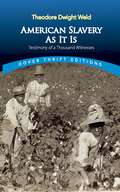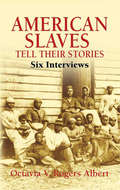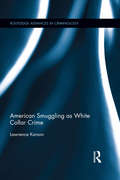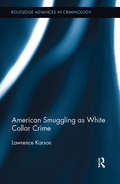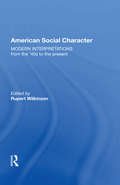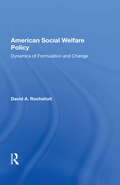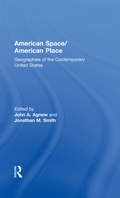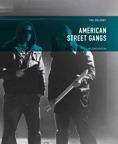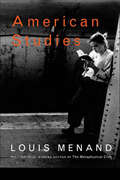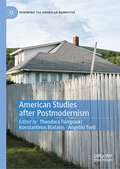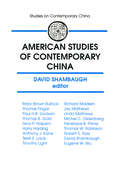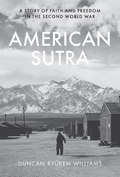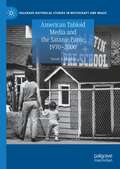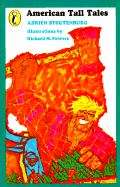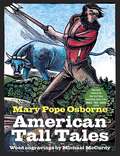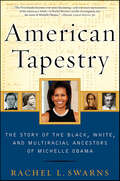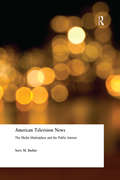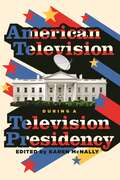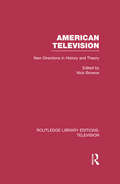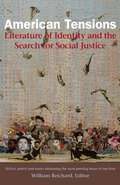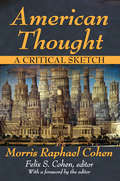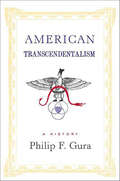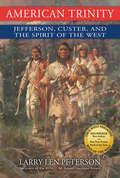- Table View
- List View
American Slavery As It Is: Selections from the Testimony of a Thousand Witnesses (Dover Thrift Editions)
by Theodore Dwight WeldThe stories of hundreds of African-Americans who lived in bondage are preserved in this powerful 1839 chronicle. Compiled by a prominent abolitionist, the accounts include personal narratives from freed slaves as well as testimonials from active and former slave owners, presenting a condemnation of slavery from both those who experienced it and those who perpetuated it. Detailing the overall conditions of slaves across multiple states and several years, the book includes information on their diet, clothing, housing, and working hours as well as their punishments and suffering.Connecticut farmer-turned-abolitionist Theodore Dwight Weld (1803–1895) was a central leader of the American Anti-Slavery Society and traveled the country lecturing against slavery. Weld took great pains to document the trustworthiness of contributors to American Slavery so that there could be no doubt as to its authenticity. A major influence on Harriet Beecher Stowe's Uncle Tom's Cabin, the book sold 100,000 copies in its first year of publication and remains a valuable historical testament. This edited selection presents these powerful first-person accounts to a new generation.
American Slavery and Russian Serfdom in the Post-Emancipation Imagination
by Amanda Brickell BellowsThe abolition of Russian serfdom in 1861 and American slavery in 1865 transformed both nations as Russian peasants and African Americans gained new rights as subjects and citizens. During the second half of the long nineteenth century, Americans and Russians responded to these societal transformations through a fascinating array of new cultural productions. Analyzing portrayals of African Americans and Russian serfs in oil paintings, advertisements, fiction, poetry, and ephemera housed in American and Russian archives, Amanda Brickell Bellows argues that these widely circulated depictions shaped collective memory of slavery and serfdom, affected the development of national consciousness, and influenced public opinion as peasants and freedpeople strove to exercise their newfound rights. While acknowledging the core differences between chattel slavery and serfdom, as well as the distinctions between each nation's post-emancipation era, Bellows highlights striking similarities between representations of slaves and serfs that were produced by elites in both nations as they sought to uphold a patriarchal vision of society. Russian peasants and African American freedpeople countered simplistic, paternalistic, and racist depictions by producing dignified self-representations of their traditions, communities, and accomplishments. This book provides an important reconsideration of post-emancipation assimilation, race, class, and political power.
American Slaves Tell Their Stories: Six Interviews (African American)
by Octavia V. AlbertVivid narratives recall life during and just after the Civil War, not only describing cruel punishments, divided families, and debilitating labor, but also providing information about religious beliefs and practices, as well as the condition and progress of former slaves. Essential reading for students of African-American studies.
American Smuggling as White Collar Crime (Routledge Advances in Criminology #17)
by Lawrence KarsonWhen Edwin Sutherland introduced the concept of white-collar crime, he referred to the respectable businessmen of his day who had, in the course of their occupations, violated the law whenever it was advantageous to do so. Yet since the founding of the American Republic, numerous otherwise respectable individuals had been involved in white-collar criminality. Using organized smuggling as an exemplar, this narrative history of American smuggling establishes that white-collar crime has always been an integral part of American history when conditions were favorable to violating the law. This dark side of the American Dream originally exposed itself in colonial times with elite merchants of communities such as Boston trafficking contraband into the colonies. It again came to the forefront during the Embargo of 1809 and continued through the War of 1812, the Civil War, nineteenth century filibustering, the Mexican Revolution and Prohibition. The author also shows that the years of illegal opium trade with China by American merchants served as precursor to the later smuggling of opium into the United States. The author confirms that each period of smuggling was a link in the continuing chain of white-collar crime in the 150 years prior to Sutherland’s assertion of corporate criminality.
American Smuggling as White Collar Crime (Routledge Advances in Sociology #17)
by Lawrence KarsonWhen Edwin Sutherland introduced the concept of white-collar crime, he referred to the respectable businessmen of his day who had, in the course of their occupations, violated the law whenever it was advantageous to do so. Yet since the founding of the American Republic, numerous otherwise respectable individuals had been involved in white-collar criminality. Using organized smuggling as an exemplar, this narrative history of American smuggling establishes that white-collar crime has always been an integral part of American history when conditions were favorable to violating the law.This dark side of the American Dream originally exposed itself in colonial times with elite merchants of communities such as Boston trafficking contraband into the colonies. It again came to the forefront during the Embargo of 1809 and continued through the War of 1812, the Civil War, nineteenth century filibustering, the Mexican Revolution and Prohibition. The author also shows that the years of illegal opium trade with China by American merchants served as precursor to the later smuggling of opium into the United States. The author confirms that each period of smuggling was a link in the continuing chain of white-collar crime in the 150 years prior to Sutherland’s assertion of corporate criminality.
American Social Character: Modern Interpretations
by Rupert WilkinsonThis anthology features the writings of 17 important analysts of American character and culture. From 1945 to the present, this book includes selections by Charles Reich, Christopher Lasch, Philip Slater and many others. There is a general introduction to the subject and each selection is preceded by an introduction and followed by a critical comme
American Social Welfare Policy: Dynamics Of Formulation And Change (Westview Special Studies In Public Policy And Public Systems Management)
by David RochefortSocial welfare activities stand at the heart of the modern democratic state as they absorb ever-increasing budget allocations and stimulate debate over the proper role of government. This study analyzes the development of social welfare policy in modern America, beginning with a critical assessment of the dominant "progressive and "social control t
American Space/American Place: Geographies of the Contemporary United States
by John A. Agnew Jonathan M. SmithAmerican Space/American Place offers geographical perspectives on the condition of the United States at the outset of the twenty-first century. It compares the American ideal of liberty, equality, individual opportunity and social improvement with the contemporary condition of the regions, states and localities--the ideal American space with its reality as a place. It uses the public standard provided by the official ideology of the United States to see how well things are really going. Agnew and Smith consider the contrast between ideal and reality at local, state and national levels in education, health, and welfare, in community, race, gender, and calss relations, in economic and industrial development, and in the use and exploitation of America's landscape. American Space/American Place provides a series of compelling insights into the current condition of American Society, its natural environment and its place within the world.
American Street Gangs
by Tim DelaneyThe text provides the necessary background material on gangs, grounding the reader with the cultural and structural context of gang activity. <P><P>Criminal activity is also connected to socioeconomic influences, thus encouraging students to consider the many factors that affect and influence gang involvement. <P><P>American Street Gangs provides a comprehensive review of all the critical elements relevant to gang life.
American Studies
by Louis MenandAt each step of this journey through American cultural history, Louis Menand has an original point to make: he explains the real significance of William James's nervous breakdown, and of the anti-Semitism in T. S. Eliot's writing. He reveals the reasons for the remarkable commercial successes of William Shawn's New Yorker and William Paley's CBS. He uncovers the connection between Larry Flynt's Hustler and Jerry Falwell's evangelism, between the atom bomb and the Scholastic Aptitude Test. He locates the importance of Richard Wright, Norman Mailer, Pauline Kael, Christopher Lasch, and Rolling Stone magazine. And he lends an ear to Al Gore in the White House as the Starr Report is finally presented to the public. Like his critically acclaimed bestseller, The Metaphysical Club, American Studies is intellectual and cultural history at its best: game and detached, with a strong curiosity about the political underpinnings of ideas and about the reasons successful ideas insinuate themselves into the culture at large. From one of our leading thinkers and critics, known both for his "sly wit and reportorial high-jinks [and] clarity and rigor" (The Nation), these essays are incisive, surprising, and impossible to put down.
American Studies after Postmodernism (Renewing the American Narrative)
by Theodora Tsimpouki Konstantinos Blatanis Angeliki TsetiThis book explores the major challenges that the long-standing and diversely debated demise of postmodernism signifies for American literature, art, culture, history, and politics, in the present, third decade of the twenty-first century. Its scope comprises a vigorous discussion of all these diverse fields undertaken by distinguished scholars as well as junior researchers, U.S. Americanists and European Americanists alike. Focusing on socio-political and cultural developments in the contemporary U.S., their contributions highlight the interconnectedness of the geopolitical, economic, environmental and technological crises that define the historical present on global scale. Chapter 16 is available open access under a Creative Commons Attribution 4.0 International License via link.springer.com.
American Studies of Contemporary China (Studies On Contemporary China)
by David L. ShambaughExamines the historical evolution of contemporary China studies in the United States, reflecting the growth and maturation of the field since the Communist Party seized power in 1949.
American Sutra: A Story of Faith and Freedom in the Second World War
by Duncan Ryūken WilliamsDuncan Ryūken Williams reveals the little-known story of how, in the darkest hours of World War II when Japanese Americans were stripped of their homes and imprisoned in camps, a community of Buddhists launched one of the most inspiring defenses of religious freedom in our nation’s history, insisting that they could be both Buddhist and American.
American TV Detective Dramas: Serial Investigations (Crime Files)
by Mareike JennerThe way detectives access and attain the 'truth' about a crime is an important indicator of how they relate to contemporary political developments. This book explores these methods of detection and positions the genre in a specific political, aesthetic, narrative and industrial context.
American Tabloid Media and the Satanic Panic, 1970-2000 (Palgrave Historical Studies in Witchcraft and Magic)
by Sarah A. HughesThis book examines the “satanic panic” of the 1980s as an essential part of the growing relationship between tabloid media and American conservative politics in the 1980s. It argues that widespread fears of Satanism in a range of cultural institutions was indispensable to the development and success of both infotainment, or tabloid content on television, and the rise of the New Right, a conservative political movement that was heavily guided by a growing coalition of influential televangelists, or evangelical preachers on television. It takes as its particular focus the hundreds of accusations that devil-worshippers were operating America’s white middle-class suburban daycare centers. Dozens of communities around the country became embroiled in trials against center owners, the most publicized of which was the McMartin Preschool trial in Manhattan Beach, California. It remains the longest and most expensive criminal trial in the nation’s history.
American Tall Tales
by Adrien StoutenburgHere are the most robust characters in American legend. Told by a poet with a poet's ear for the impact of words, these American mavericks walk and talk across the pages in a free, wide way, as they walked and talked across the free, wide America of pioneer days.
American Tall Tales
by Mary Pope Osborne Michael MccurdyCelebrating the 15th anniversary of these collection of tales. There are among nine "tall" heroes featured in this exuberant collection of traditional American folk tales, including Paul Bunyan, Johnny Apple seed, John Henry, and other American folk heroes.
American Tapestry: The Story of the Black, White, and Multiracial Ancestors of Michelle Obama
by Rachel L. Swarns“Riveting . . . American Tapestry is not only the remarkable story of the First Lady’s family, but also a microcosm of this country’s story as well.” —USA TodayIn this extraordinary feat of genealogical research—in the tradition of The Hemmingses of Monticello and Slaves in the Family—author Swarns, a respected Washington-based reporter for the New York Times, tells the fascinating and hitherto untold story of Ms. Obama’s black, white, and multiracial ancestors; a history that the First Lady herself did not know.At once epic, provocative, and inspiring, American Tapestry is more than a true family saga; it is an illuminating mirror in which we may all see ourselves.“The First Family becomes ever more fascinating—and ever more representative of the nation as a whole—in Rachel Swarns’s terrific investigation into the roots of Michelle Obama . . . This is a most compelling read and more evidence for our interconnectedness as a people.” —Henry Louis Gates, Jr.“Rachel Swarns has not only excavated, with painstaking care, the family tree that is Michelle Obama’s, but, with great insight and beautiful prose, has revealed the complex, eye-opening, and disconcerting experiences that are America. This is a work of impressive historical imagination and deep cultural significance.” —Steven Hahn, Pulitzer Prize-winning author“Richly detailed . . . A lushly layered portrait of the nation itself.” —The Boston Globe“A fascinating account of the First Lady’s family . . . Few important women come from such raw places. The book makes you remember why the Obamas . . . seemed so new, so implausible . . . Extraordinary.” —The New York Times
American Television News: The Media Marketplace and the Public Interest
by Steve M. BarkinThis concise history of the news broadcasting industry will appeal to both students and general readers. Stretching from the "radio days" of the 1920s and 1930s and the early era of television after World War II through to the present, the book shows how commercial interests, regulatory matters, and financial considerations have long shaped the broadcasting business. The network dominance of the 1950s ushered in the new prominence of the "anchorman," a distinctly American development, and gave birth to the "golden age" of TV broadcasting, which featured hard-hitting news and documentaries epitomized by the reports by CBS's Edward R. Murrow. Financial pressures and advertising concerns in the 1960s led the networks to veer away from their commitment to serve the public interest, and "tabloid" television - celebrity, gossip-driven "soft news" - and news "magazines" became increasingly widespread. In the 1980s cable news further transformed broadcasting, igniting intense competition for viewers in the media marketplace. Focusing on both national and local news, this stimulating volume examines the evolution of broadcast journalism. It also considers how new electronic technologies will affect news delivery in the 21st century, and whether television news can still both serve the public interest and maintain an audience.
American Television during a Television Presidency (Contemporary Approaches to Film and Media Series)
by Steven Cohan Donna Peberdy Oliver Gruner Hannah Andrews Simon Stow Kathryn Castle Michael Mario Albrecht Aimee Mollaghan Martin Murray Karen McNally Teresa Forde Gregory Frame K. Scott Culpepper Kwakiutl L. Dreher Jessica Ford Rafal Kus Dolores Resano Martin Zeller-JacquesIn American Television during a Television Presidency, Karen McNally and contributors critically examine the various ways in which television became transfixed by the Trump presidency and the broader political, social, and cultural climate. This book is the first to fully address the relationship between TV and a presidency consistently conducted with television in mind. The sixteen chapters cover everything from the political theater of televised impeachment hearings to the potent narratives of fictional drama and the stinging critiques of comedy, as they consider the wide-ranging ways in which television engages with the shifting political culture that emerged during this period. Approaching television both historically and in the contemporary moment, the contributors¾an international group of scholars from a variety of academic disciplines¾illuminate the indelible links that exist between television, American politics, and the nation’s broader culture. As it interrogates a presidency played out through the lens of the TV camera and reviews a medium immersing itself in a compelling and inescapable subject, American Television during a Television Presidency sets out to explore what defines the television of the Trump era as a distinctive time in TV history. From inequalities to resistance, and from fandom to historical memory, this book opens up new territory in which to critically analyze television’s complex relationship with Donald Trump, his presidency, and the political culture of this unsettled and simultaneously groundbreaking era. Undergraduate and graduate students and scholars of film and television studies, comedy studies, and cultural studies will value this strong collection.
American Television: New Directions in History and Theory (Routledge Library Editions: Television)
by Nick BrowneThis work brings together writings on television published in Quarterly Review of Film and Video, from essays by Nick Browne and Beverle Houston to the latest historical and critical research. It considers television's economics, technologies, forms and audiences from a cultural perspective that links history, theory and criticism. The authors address several key issues: the formative period in American television history; the relation between television's political economy and its cultural forms; gender and melodrama; and new technologies such as video games and camcorders. Originally published in 1993.
American Tensions: Literature of Identity and the Search for Social Justice
by William ReichardThis anthology of contemporary American poetry, short fiction, and nonfiction, explores issues of identity, oppression, injustice, and social change. Living American writers produced each piece between 1980 and the present; works were selected based on literary merit and the manner in which they address one or more pressing social issues. William Reichard has assembled some of the most respected literary artists of our time, asking whose voices are ascendant, whose silenced, and why. The work as a whole reveals shifting perspectives and the changing role of writing in the social justice arena over the last few decades.
American Thought: A Critical Sketch
by Morris CohenWhat constitutes American thought is obviously too elusive to be encompassed by any one writer or group of writers. The best that any attempt at intellectual history can achieve is to indicate some of its traces in written records. This volume represents the eff orts of one of America's leading philosophers to do just that. He is uniquely qualified to do so, as his contemporary Sidney Hook well understood.As Cohen noted, most of what people say and write is dominated by linguistic forms or habits. Thus the dominance of the traditions and habits that make up the English language has been the strongest single infl uence in fashioning American thought as very largely a province of British thought - despite the Declaration of Independence and two wars. Cohen describes how American thought developed from its British roots. It deals with reflective thought, i.e. with thought that is conscious of its problems, of its methods and of the widest general bearings of the results obtained so far. The diverse subjects discussed range from religious thinking to the scientific, and from the legal tradition to literary criticism.Among the important figures Cohen assesses are Dewey, Santayana, Holmes, Brandeis, Whitehead, James, and Royce as well as those of men less well-known but sometimes equally influential. In its scope and insight, this book takes its own unique and important place in American thought.
American Transcendentalism: A History
by Philip F. GuraThe first comprehensive history of the nineteenth-century American intellectual movement.American Transcendentalism is a comprehensive narrative history of America’s first group of public intellectuals, the men and women who defined American literature and indelibly marked American reform in the decades before and following the America Civil War. Philip F. Gura masterfully traces their intellectual genealogy to transatlantic religious and philosophical ideas, illustrating how these informed the fierce local theological debates that, so often first in Massachusetts and eventually throughout America, gave rise to practical, personal, and quixotic attempts to improve, even perfect the world. The transcendentalists would painfully bifurcate over what could be attained and how, one half epitomized by Ralph Waldo Emerson and stressing self-reliant individualism, the other by Orestes Brownson, George Ripley, and Theodore Parker, emphasizing commitment to the larger social good.By the 1850s, the uniquely American problem of slavery dissolved differences as transcendentalists turned ever more exclusively to abolition. Along with their early inheritance from European Romanticism, America’s transcendentalists abandoned their interest in general humanitarian reform. By war’s end, transcendentalism had become identified exclusively with Emersonian self-reliance, congruent with the national ethos of political liberalism and market capitalism.
American Trinity: Jefferson, Custer, and the Spirit of the West
by Larry Len PetersonAmerican Trinity is for everyone who loves the American West and wants to learn more about the good, the bad, and the ugly. It is a sprawling story with a scholarly approach in method but accessible in manner. In this innovative examination, Dr. Larry Len Peterson explores the origins, development, and consequences of hatred and racism from the time modern humans left Africa 100,000 years ago to the forced placement of Indian children on off-reservation schools far from home in the late 1800s. Along the way, dozens of notable individuals and cultures are profiled. Many historical events turned on the lives of legendary Americans like the "Father of the West," Thomas Jefferson, and the "Son of the West," George Armstrong Custer - two strange companions who shared an unshakable sense of their own skills - as their interpretation of truths motivated them in the winning of the West.Dr. Peterson reveals how anti-Indian sentiments were always only obliquely about them. They were victims but not the cause. The Indian was a symbol, not a real person. The politics of hate and racism directed toward them was also experienced in prior centuries by Jews, enslaved Africans, and other Christians. Hatred and racism, when taken into the public domain, are singularly difficult to justify, which is why Europeans and Americans have always sought vindication from the highest sources of authority in their cultures. In the Middle Ages it was religion supplemented later by the philosophy of the Enlightenment. In nineteenth-century Europe and America, religion and philosophy were joined by science and medicine to support Manifest Destiny, scientific racism, and social Darwinism, all of which had profound consequences on Native Americans and the Spirit of the West.Presenting research in anthropology, archaeology, biology, history, law, medicine, religion, philosophy, and psychology, Dr. Peterson provides the latest observations that delineate why the Native American's life was destroyed. American Trinity is a stunning portrait, a view at once unique, panoramic, and intimate. It is a fascinating book that will make you think about the differences between belief and knowledge; about the self-skepticism of science and medicine; and about what aspects of the world we take on faith.
